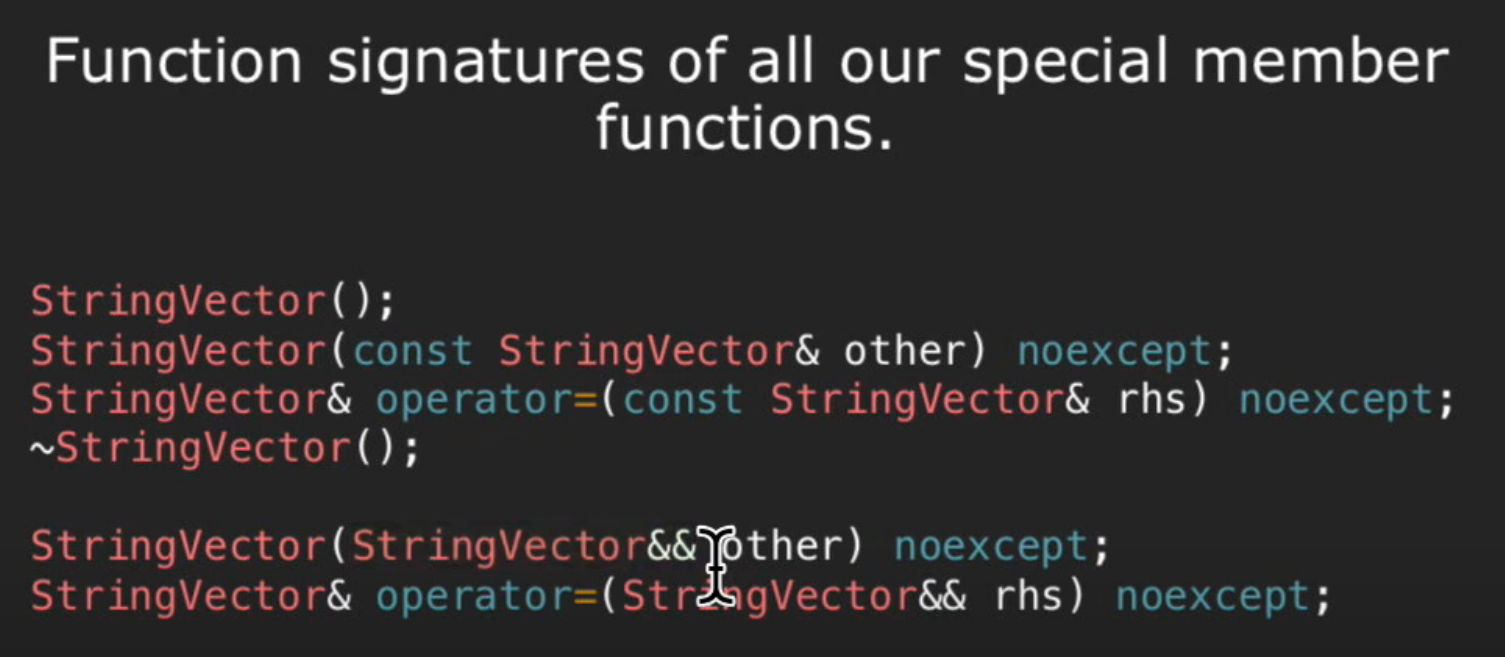Lec 13: Move Semantics
Introduction: push_back vs emplace_back
#include <vector>
#include <iostream>
using namespace std;
class Test {
public:
Test() : count(0) {}
Test(const Test& other) noexcept {
this->count = other.count + 1;
}
~Test() {
// default
}
void operator() () {
cout << count << ' ';
}
private:
int count;
};
int main() {
vector<Test> t;
t.push_back(Test()); // output: 3
t.emplace_back(); // output: 1
for (auto i : t) {
i();
}
return 0;
}
Recap: Destructor
#include <bits/stdc++.h>
using namespace std;
class Test {
public:
Test() = delete;
Test(string str) : tt(str) {
cout << tt << " is constructed via `string` \n";
}
Test(const Test& other) {
tt = other.tt;
cout << tt << " is constructed via `Test&` \n";
}
~Test() {
cout << tt << " is destructed \n";
}
Test& operator=(const Test& other) {
cout << tt << " is assigned to " << other.tt << '\n';
tt = other.tt;
return *this;
}
private:
string tt;
};
void mark_times() {
static int time = 1;
cout << "Mark: " << time << '\n';
++time;
}
Test fun (Test t) {
mark_times();
return t;
}
int main() {
Test test1("Hello");
mark_times();
Test test2("World");
mark_times();
test1 = fun(test2);
mark_times();
cout << "final test\n";
test2 = fun(static_cast<string>("CS106L"));
mark_times();
return 0;
}
Output (with flag -Og -fno-elide-constructors):
Hello is constructed via `string`
Mark: 1
World is constructed via `string`
Mark: 2
World is constructed via `Test&`
Mark: 3
World is constructed via `Test&`
Hello is assigned to World
World is destructed
World is destructed
Mark: 4
final test
CS106L is constructed via `string`
CS106L is constructed via `Test&`
Mark: 5
CS106L is constructed via `Test&`
World is assigned to CS106L
CS106L is destructed
CS106L is destructed
CS106L is destructed
Mark: 6
CS106L is destructed
World is destructed
So:
- temporary objects will be destructed after the program goes to the next line
- all non-
newobjects will be destructed after reaching} - when calling
test(static_cast<string>("CS106L")), three temp objects will be created (and destructed) - first,
(string)"CS106L"toTest temp1- if you discard the
-fno-elide-constructorsflag, the first and second steps can be merged into one step
- if you discard the
- second,
Test temp1toTest t - finally,
Test ttoreturn
l-value vs r-value
This is a simplification of the reality, but it's enough for today's topic.
l-value is a value with an identity
- can be addressed
r-value has no identity.
- can't be addressed
r-value reference
int main()
{
int a = 1;
int &b = a;
int &c = a + 2; // error: cannot bind non-const lvalue reference to an rvalue
const int &d = a + 2;
int &&e = a; // error: cannot bind rvalue reference to lvalue
int &&f = a + 2;
}
Why r-value is the key to std::move
An object that is an I-value is NOT disposable, so you can copy from, but definitely cannot move from.
An object that is an r-value is disposable, so you can either copy or move from.
- "move" here just means "steal"
Move constructor and move assignment

The move constructor and move assignment are at the bottom two lines.
Rule of thumb: If your class has copy constructor and copy assignment defined, you should also define a move constructor and move assignment.
So, if RHS is an r-value, we use move constructor; if not, we use normal constructor.
- Notice actually you can bind
const Type&to an r-value, but C++11 standard says if you are encountered with a r-value,Type &&is the priority.
The actual meaning of r-value reference, is:
Provide the (temporary) r-value a name, so I can easily manipulate the data within it later.
And, since r-value reference itself is l-value, its elements are l-values. So we must cast them to r-value.
In this case, we use std::move.
class StrVector {
public:
// ...
StrVector (StrVector&& other) : elems(std::move(other.elems)), logicalSize(other.logicalSize), allocatedSize(other.allocatedSize)
{
other.elems = nullptr;
}
};
Example: swap
template <typename T>
void my_swap(T& a, T& b)
{
T temp = std::move(a);
// now a is undefined
a = std::move(b);
// now b is undefined, and is given to a (i.e. a is defined)
b = std::move(temp);
// now temp is undefined, and is given to b (i.e. b is defined)
// Finally, temp is undefined, and a, b are swapped.
}